BAFA © 2010. All material here is copyrighted. See conditions above. |
Margaret Bremner,
mandala paintings, Canada
|
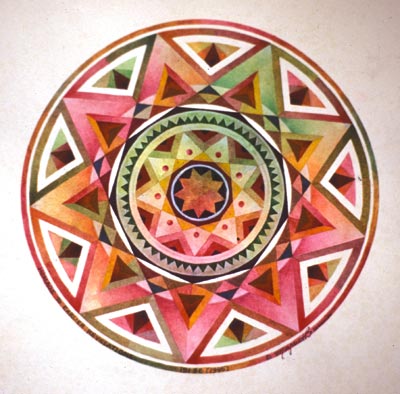
Hommage to Earlier Revelations
mandala painting by Margaret Bremner.
| The Circle: A Cross-cultural Spiritual Symbol
by Margaret Bremner, Canada.
I graduated with a Bachelor of Fine Arts degree from the University of Saskatchewan in Saskatoon in 1977, and in the spring of 1995 I realized that in my artwork I regularly returned to the circle form. I decided to focus on this for a while and see where it led. Doors open constantly!
I continually discover more information and conceive new ideas. Mandala paintings are now the majority of my output.
International or universal imagery has always been of greater interest to me than local or regional subjects. I am attracted to designs and images from other cultures. And I always preferred geometry to algebra!
|
My artwork has usually involved vibrant color and intricate detail. I generally work in mixed media. This usually includes any or all of the following: watercolor, colored pencil, acrylic, pen-and-ink, and collage. I then frequently add things like colored sand, glitter, metal or wooden discs, and plastic pieces. Sometimes I base a work on an existing mandala form (snowflake, Viking medallion, etc.), and sometimes it is of my own invention. When I create a mandala I enjoy playing with color and form and ideas, but I am also stating my belief in the oneness of humanity and alluding to the interconnection of everything in God's creation.
Having neither beginning nor end, the circle has long been a symbol - across time and culture - of wholeness, protection, unity, integration, transformation and eternity.
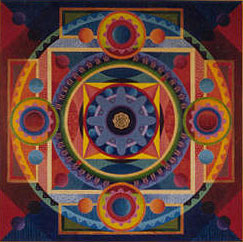 Mandada painting by Margaret Bremner. | |
The circle evokes many analogies: the full moon or the sun, the circumference of the visible horizon, the pupil of the eye, and seasonal cycles, to name a few. In striving towards the spiritual, humankind has, over the centuries, constructed circle-forms. These frequently appear in connection with spiritually oriented activities or locations, however primitive or modern.
Some examples are:
- the stained glass rose windows found in many Gothic churches
- stonehenges; many of which are found in Great Britain
- Buddhist Noble Eightfold Path (or 'Way'), symbolized by an eight-spoked wheel
- Bahá'í houses of worship
- North American aboriginal stone medicine wheels
- Yin Yang, symbolic of many opposites (male/female, youth /age, celestial/earthly, here/there...)
- the Aztec calendar stone (or sun stone)
|
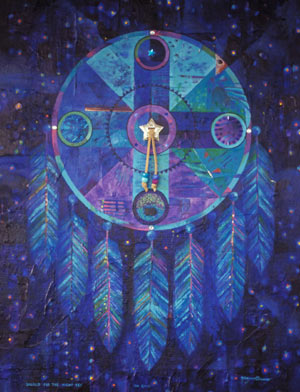
Sheild for the Night
mandala painting by Margaret Bremner.
| The beginning, in Indian traditions, was a Sound; in the Gospel of John it was the Word. When a sound is made, the sound waves emanate out from the point of origin in a mandala form- much as do ripples on the water's surface when a stone is dropped in. In other stories, the beginning is Light, and light waves, too, emanate from the center in a similar fashion. Modern science proposes the beginning as a Big Bang. An image of an explosion is also a kind of mandala resembling a sunburst. Stan Tenen, director of the Meru Foundation, has said, "The forms of sacred geometry do not represent things, they represent processes. Pictures and models of things, after all, are frozen. They are not at all alive. For sacred forms to be sacred, we must see them as snapshots of the processes of life."
"Mandala" is a Sanskrit word meaning 'circle': the circumference, the center, and everything in between. The center of a circle is a point. A point has no dimension, and therefore does not belong to our physical world. A point contains everything potentially, but not yet in manifest form. A mandala symbolizes the interdependence and unity of everything in creation whereby all the disparate parts are associated by virtue of their relationship to the center. |
"Mandala" has also been translated as 'sacred assembly', 'essence container', 'circle with a center', 'mystic circle' and 'sacred circle'. Mandalas are readily evident in everyday life; they occur both in natural and man-made forms. Think for a moment about these things: a daisy.... a dartboard .... a cross-section of an orange .... a clock ..... a snowflake ..... a bicycle wheel ..... a lotus ..... a compass ....... a cross-section of a tree trunk ..... a sunflower.
In the West the word mandala has come to be the term used for artwork in a circular form, specifically two-dimensional work constructed in a concentric circular format, usually rather complex, with symmetrical divisions, and various elements radiating to or from the center.
The four sides or corners are reminiscent of the four cardinal compass directions.

God's Eye painting by Margaret Bremner.
| |
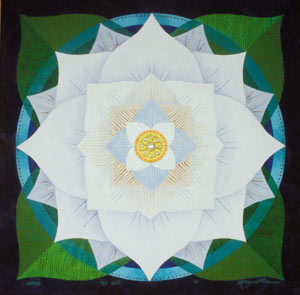
Lotus, mandala painting by Margaret Bremner.
| In many cultures mandalas are used as a meditational aid. Meditation with a mandala can lead inward towards the center of oneís being and a better understanding of the self, or outward to a more expansive view of the universe. It also leads from the single point of origin to the multifarious diversity of the phenomenal world, and from the peripheral edges of the ego's domain toward the center point where all becomes one. In some traditions the "circle, squared" (circle and square together) represents the connection between our spiritual (circle) and physical (square) natures.
Position yourself at the center of a mandala and the Seven Sacred Directions of the north American natives can be imagined: east, south, west, and north, (or front, right, back, and left), then upward (towards the heavens and the Creator), downward (towards Mother Earth), and inward (towards enlightenment).
|
On a personal level a mandala is a visual expression of the interconnection between the many facets of our being. The series of concentric forms suggests the progressive passage between various stages of development. The mandala is thus a symbol of potential and of transformation. On a grander scale, a mandala is a cosmogram, a human-scale symbol of the universe. It represents everything from the enormity of a whirling galaxy to the infinitesimal rotating particles of an atom.
An investigation of mandalas will touch on many varied cultures, times, systems, and beliefs - all with one aim: to discover harmony in the diversity, and so to find one's way to the center.
"Everything the Power of the World does, is done in a circle. The sky is round and I have heard that the earth is round like a ball, and so are all the stars. The wind, in its greatest power, whirls. Birds make their nests in circles,
|

Mandala painting by Margaret Bremner.
|
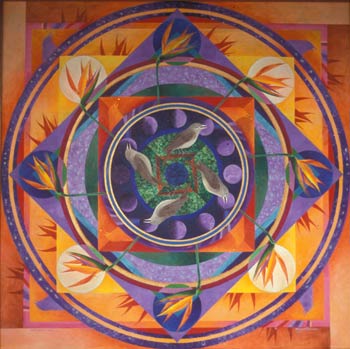
Nightingale Song, mandala painting by Margaret Bremner.
|
for theirs is the same religion as ours. The sun comes forth and goes down again in a circle. The moon does the same, and both are round. Even the seasons form a great circle in their changing, and always come back again to where they were. The life of a man is a circle from childhood to childhood, and so it is in everything where power moves. Our teepees were round like the nests of birds, and these were always set in a circle; the nation's hoop, a nest of many nests where the Great Spirit meant for us to hatch our children."
 - Black Elk, a medicine man and visionary of the Oglala Sioux. - Black Elk, a medicine man and visionary of the Oglala Sioux.
Excerpts from Arts Dialogue, December 1997, Arts Dialogue. pages 13 - 14.
|
- Article + Photographs: in the book, Just Let the Wind, 2006
- Article & Illustrations: The Circle: a cross-cultural spiritual symbol, Arts Dialogue, December 1997
- Illustration: mandala painting, Vibrating Influence, Arts Dialogue, December 1996
|

Arts Dialogue, Dintel 20, NL 7333 MC, Apeldoorn, The Netherlands
email: bafa@bahai-library.com
|
|






